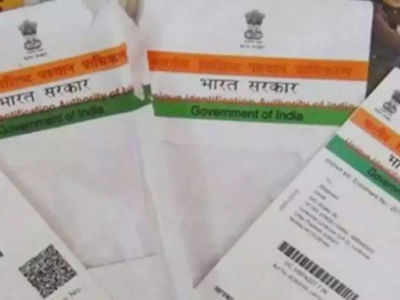- News
- Business News
- A brief history of the unique identity project
Trending
This story is from September 27, 2018
A brief history of the unique identity project
Twelve years after it was conceived, Aadhaar overcomes several legal challenges to become constitutionally valid.

Twelve years after it was conceived, Aadhaar overcomes several legal challenges to become constitutionally valid.
Key Highlights
- In March 2006, the ministry of communications and information technoology approves a Unique ID (UID) scheme for poor families
- In December 2010, the National Identification Authority of India (NIAI) Bill, 2010 is introduced in Parliament.
Twelve years after it was conceived, Aadhaar overcomes several legal challenges to become constitutionally valid.
1. AADHAAR IS BORN
In March 2006, the ministry of communications and information technology approves a Unique ID (UID) scheme for poor families. At its first meeting in 2007, the empowered group of ministers (EGoM) recognises need to create a residents’ database.This leads to the creation of Aadhaar.
2. ENTER NILEKANI
3. PRIVACY FIRST
In December 2010, the National Identification Authority of India (NIAI) Bill, 2010 is introduced in Parliament. But a year later, the standing committee on finance rejects the bill in its initial form; recommends requirement of privacy legislation and data protection law before the scheme is continued.
4. LEGAL BATTLE BEGINS
KS Puttaswamy, a retired judge of the Karnataka high court, mounts the first legal challenge to Aadhaar in 2012, says it violates fundamental rights of equality and privacy.
5.SC STEPS IN
Supreme Court passes an interim order in September 2013 stating no person should suffer for not having an Aadhaar card. In August 2015, three-judge SC bench limits Aadhaar use to certain welfare schemes, orders that no one should be denied benefits for lack of an Aadhaar card.
6. BUT AADHAAR BECOMES A MUST
In March 2016, government introduces Aadhaar (Targeted Delivery of Financial & Other Subsidies, Benefi ts & Services) Bill as a money bill in Lok Sabha. Bill passed by Parliament; receives presidential assent. By early 2017, various ministries make Aadhaar mandatory for welfare, pension, and employment schemes. Aadhaar made mandatory for filing of income tax returns.
7. OVER TO CONSTITUTION BENCH
On July 7, 2017, SC says all Aadhaar issues will be addressed by a constitution bench. On January 17, 2018, a five-judge constitution bench begins hearing 30 petitions challenging Aadhaar’s validity. In March, after 2 months of arguments against Aadhaar, the Centre begins its defense. On May 10, court reserves verdict. The 38-day hearing is the second longest oral hearing after the 1973 Keshavananda Bharti case.
8. SC UPHOLDS AADHAAR CONSTITUTIONAL
On September 26, 2018, SC upholds the validity of the Aadhaar, but weeds out provisions with potential for misuse. Aadhaar to be linked to PAN, filing IT returns and availing government subsidies, but not needed to open bank accounts, get SIM cards, school admissions, taking examinations, etc.


Source: Media reports
1. AADHAAR IS BORN
In March 2006, the ministry of communications and information technology approves a Unique ID (UID) scheme for poor families. At its first meeting in 2007, the empowered group of ministers (EGoM) recognises need to create a residents’ database.This leads to the creation of Aadhaar.
2. ENTER NILEKANI
The Unique Identification Authority of India (UIDAI) is created in 2009 to issue unique identification numbers. Nandan Nilekani appointed the first chairman.
3. PRIVACY FIRST
In December 2010, the National Identification Authority of India (NIAI) Bill, 2010 is introduced in Parliament. But a year later, the standing committee on finance rejects the bill in its initial form; recommends requirement of privacy legislation and data protection law before the scheme is continued.
4. LEGAL BATTLE BEGINS
KS Puttaswamy, a retired judge of the Karnataka high court, mounts the first legal challenge to Aadhaar in 2012, says it violates fundamental rights of equality and privacy.
5.SC STEPS IN
Supreme Court passes an interim order in September 2013 stating no person should suffer for not having an Aadhaar card. In August 2015, three-judge SC bench limits Aadhaar use to certain welfare schemes, orders that no one should be denied benefits for lack of an Aadhaar card.
6. BUT AADHAAR BECOMES A MUST
In March 2016, government introduces Aadhaar (Targeted Delivery of Financial & Other Subsidies, Benefi ts & Services) Bill as a money bill in Lok Sabha. Bill passed by Parliament; receives presidential assent. By early 2017, various ministries make Aadhaar mandatory for welfare, pension, and employment schemes. Aadhaar made mandatory for filing of income tax returns.
7. OVER TO CONSTITUTION BENCH
On July 7, 2017, SC says all Aadhaar issues will be addressed by a constitution bench. On January 17, 2018, a five-judge constitution bench begins hearing 30 petitions challenging Aadhaar’s validity. In March, after 2 months of arguments against Aadhaar, the Centre begins its defense. On May 10, court reserves verdict. The 38-day hearing is the second longest oral hearing after the 1973 Keshavananda Bharti case.
8. SC UPHOLDS AADHAAR CONSTITUTIONAL
On September 26, 2018, SC upholds the validity of the Aadhaar, but weeds out provisions with potential for misuse. Aadhaar to be linked to PAN, filing IT returns and availing government subsidies, but not needed to open bank accounts, get SIM cards, school admissions, taking examinations, etc.


Source: Media reports
End of Article
FOLLOW US ON SOCIAL MEDIA















